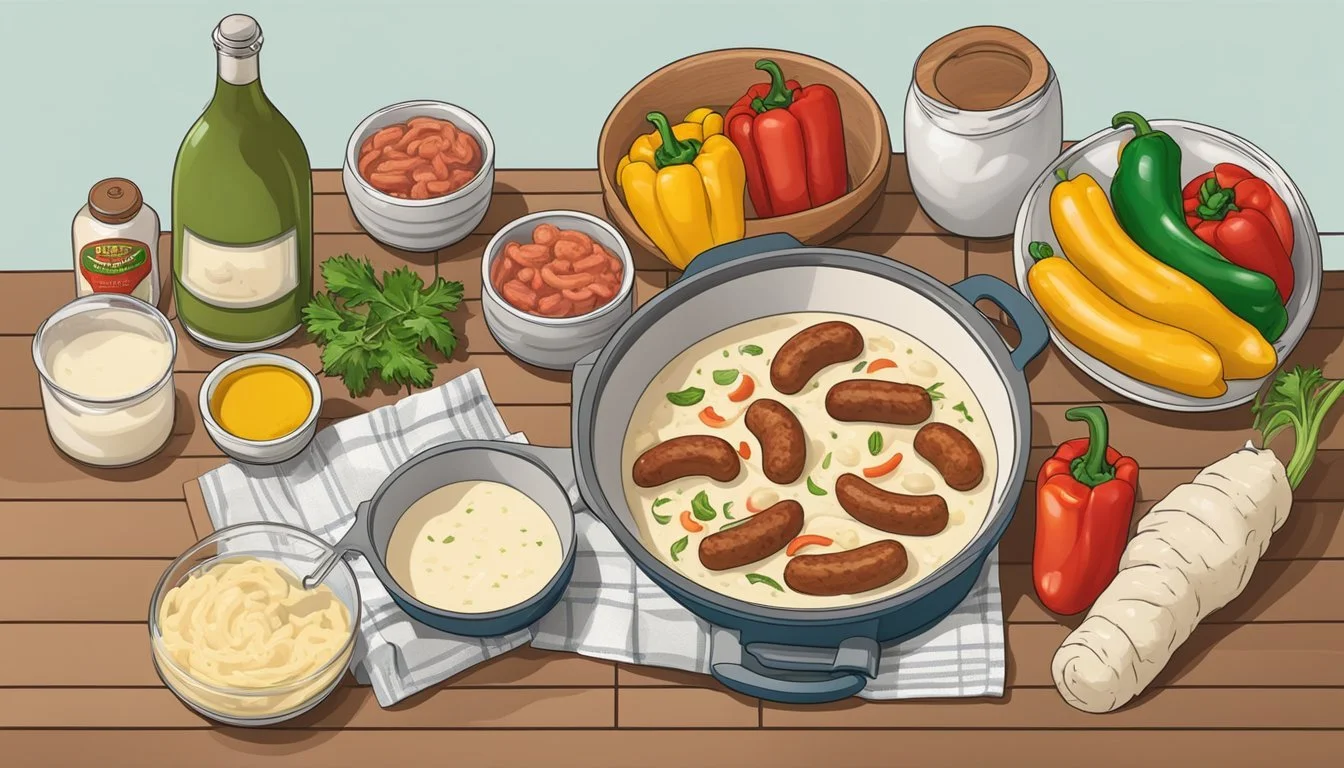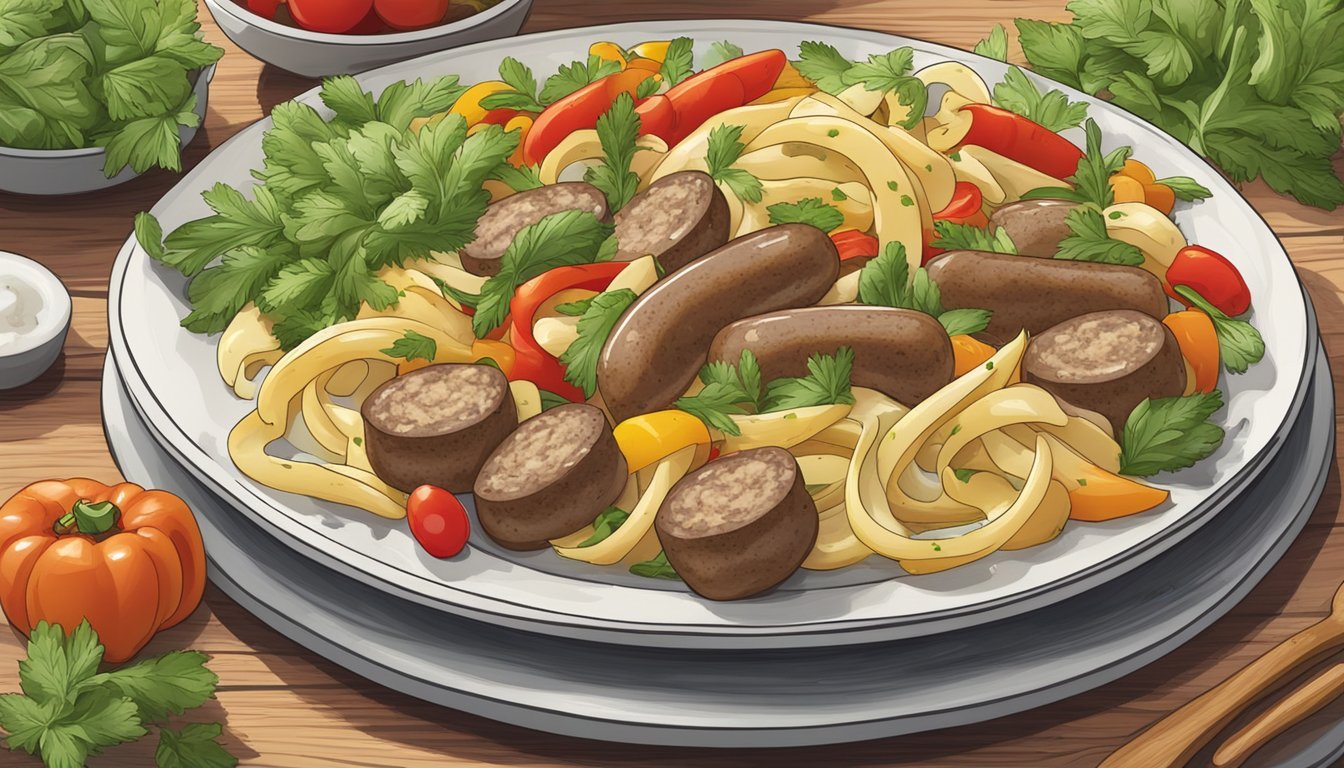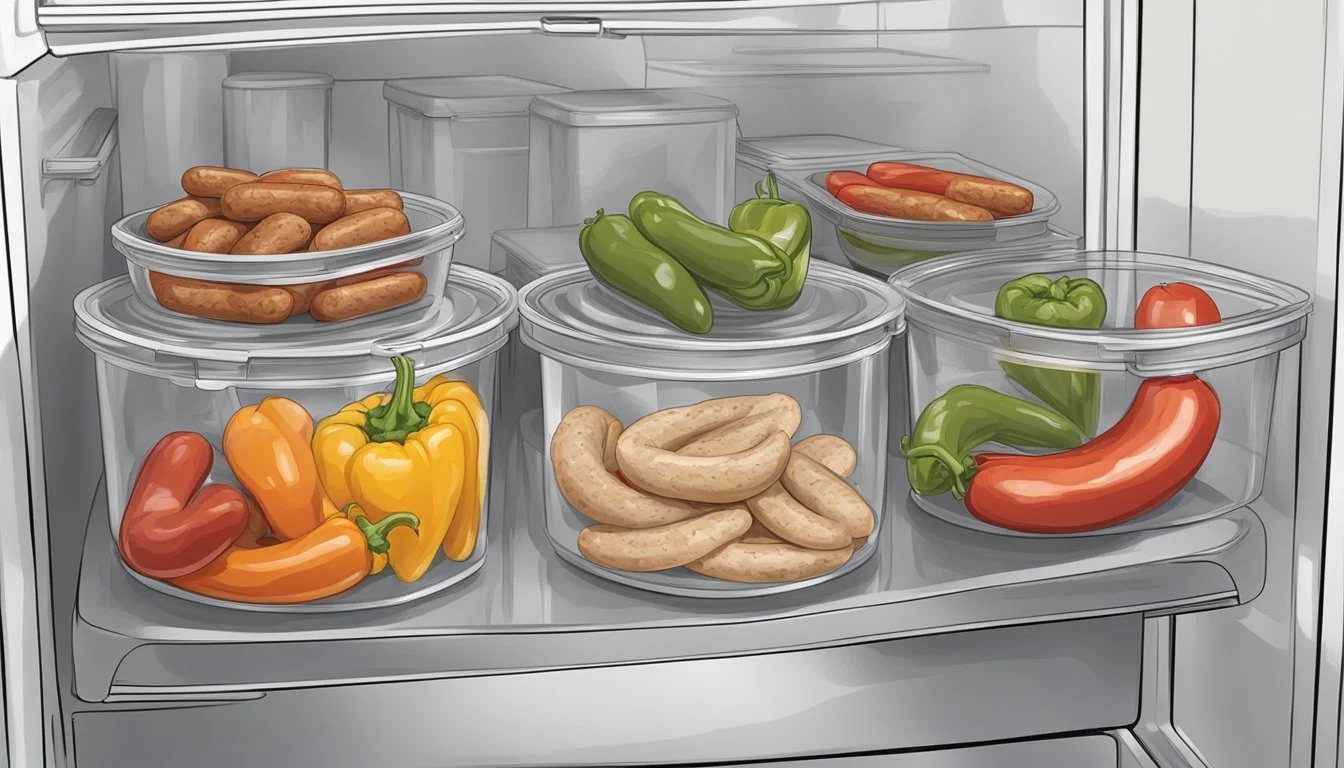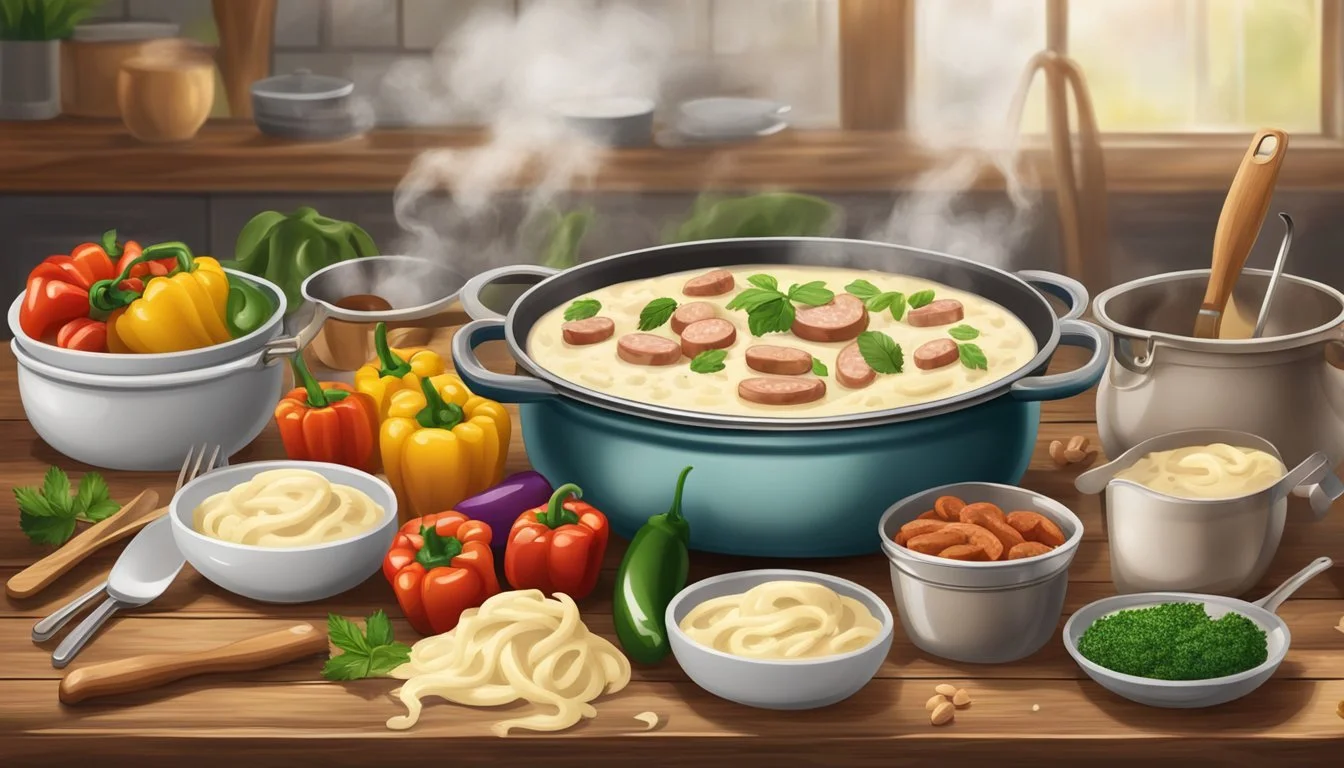How Long Does Alfredo Sausage and Peppers Last?
Storage Tips and Shelf Life Explained
Food safety is a crucial aspect to consider when enjoying delicious homemade meals. For many, Italian favorites like Alfredo sausage and peppers top the list. Whether you're planning to store leftovers or simply want to prep meals ahead of time, understanding the shelf life of this dish can help maintain both taste and safety.
Alfredo sausage and peppers will typically last for 3-4 days when stored properly in the refrigerator. To maximize freshness, it's essential to store the dish in airtight containers as soon as it cools. Freezing is also a viable option, extending the dish's lifespan to about 2-3 months while preserving its flavor and texture.
Proper storage techniques are essential to ensure that your Alfredo sausage and peppers stay delicious and safe to eat. Placing the meal in an airtight container and refrigerating or freezing it promptly can keep it fresh and prevent spoilage. Knowing these storage tips can help you enjoy your favorite meals with peace of mind.
Understanding Alfredo Sausage and Peppers
This dish combines the rich, creamy flavors of traditional Alfredo sauce with the savory taste of sausage and the subtle sweetness of peppers, creating a hearty and delightful meal.
Defining the Dish
Alfredo Sausage and Peppers is a fusion of classic Italian and American flavors. The dish typically features Italian sausage, sweet bell peppers, pasta, and a creamy Alfredo sauce.
The Alfredo sauce, made with cream and Parmesan cheese, coats the pasta and sausage, creating a rich and satisfying meal. Garlic and Italian seasoning enhance the overall taste, offering a well-rounded flavor profile.
Key Ingredients
Italian Sausage: This type of sausage is known for its robust flavor and is often used as the primary protein. It is typically cooked until browned and then combined with other ingredients.
Peppers: Bell peppers, either red, yellow, or green, add a sweet and slightly crunchy element to the dish, balancing the richness of the Alfredo sauce.
Pasta: Popular choices include penne or fettuccine, which hold the sauce well and ensure every bite is flavorful.
Cream and Parmesan Cheese: The base of any Alfredo sauce, these ingredients provide the creamy, cheesy texture that is essential for the dish.
Garlic and Italian Seasoning: These add depth and extra flavor, making the dish aromatic and well-seasoned. Garlic is usually sautéed in butter before adding the cream and cheese to create the Alfredo sauce.
This carefully chosen blend of ingredients results in a comforting and filling meal that highlights the delicious harmony of flavors in Alfredo Sausage and Peppers.
Preparation Techniques
Preparing Alfredo with sausage and peppers involves understanding the best ways to cook and the right temperatures to ensure both flavor and safety.
Cooking Instructions
Start by cooking the sausages in a skillet over medium heat. Use a little olive oil or cooking spray to prevent sticking. Rotate the sausages occasionally to ensure even browning on all sides. Once browned, remove the sausages and set them aside.
In the same skillet, add sliced bell peppers and onions. Sauté these until they are tender. This should take about 5-7 minutes. Add mushrooms if desired and cook for an additional 2-3 minutes.
Once the vegetables are cooked, incorporate heavy cream or half-and-half, allowing it to simmer gently. Gradually stir in grated Parmesan and Romano cheeses until melted. Combine the cooked sausage with the sauce and vegetables. Finally, toss the mixture with cooked pasta until well-coated.
Optimal Cooking Temperatures
Cooking temperatures play a crucial role in making this dish safe and enjoyable. Sausages should reach an internal temperature of 160°F (71°C) to ensure they are fully cooked. Use a meat thermometer to check the doneness.
When baking sausage and peppers in the oven, preheat to 400°F (200°C). This temperature allows the sausages and vegetables to cook evenly. Bake for 25-30 minutes, or until the peppers are tender and the sausages are thoroughly cooked.
For the Alfredo sauce, heat the cream mixture to a gentle simmer, avoiding a full boil to prevent curdling. Keep the mixture on low to medium heat while adding the cheese, ensuring it melts smoothly into the sauce.
This preparation ensures the dish is flavorful and safe to consume.
Nutritional Profile
Alfredo sausage and peppers is a hearty dish that combines protein, fats, and carbohydrates. It offers a rich and satisfying meal option for many.
Calories: The calorie content can vary based on the ingredients used. Typically, a serving can range from 500 to 700 calories. This includes pasta, sausage, Alfredo sauce, and peppers.
Protein: Sausage provides a significant protein source. A single serving can contain around 20-25 grams of protein, contributing to muscle maintenance and overall health.
Carbohydrates: Alfredo pasta is carbohydrate-rich, primarily from the pasta. A serving may contain around 50-60 grams of carbohydrates, providing energy needed for daily activities.
Fats: This dish includes fats from the sausage and Alfredo sauce. Depending on the recipe, fats can range from 20 to 30 grams per serving. These contribute to flavor and satiety.
Additional Nutrients:
Fiber: Minimal to moderate, depending on the pasta type and veggies used.
Vitamins and Minerals: Peppers add vitamins A and C, while cheeses in the sauce contribute calcium and phosphorus.
Monitoring portion sizes and ingredient choices helps manage the nutritional intake from Alfredo sausage and peppers.
Storing Leftovers
When storing leftovers, especially dishes like alfredo sausage and peppers, it is crucial to follow proper refrigeration and freezing practices to ensure food safety and maximize shelf life.
Refrigeration Best Practices
To keep alfredo sausage and peppers safe for consumption, it is important to refrigerate them within two hours of cooking. Store the leftovers in an airtight container to maintain freshness and prevent contamination. In the fridge, this dish typically lasts for 3 to 5 days.
Ensure the refrigerator temperature is set at or below 40°F (4°C) to inhibit bacterial growth. Regularly check and discard any leftovers that show signs of spoilage, such as off smells, discoloration, or texture changes.
Can You Freeze Alfredo Sausage and Peppers?
Yes, alfredo sausage and peppers can be frozen to extend their shelf life. When freezing, use freezer-safe, airtight containers or bags to prevent freezer burn and maintain quality. This dish can usually be kept in the freezer for up to 2 months.
Before freezing, allow the dish to cool completely to prevent condensation, which can affect texture. When ready to eat, thaw the leftovers in the fridge overnight and thoroughly reheat to an internal temperature of 165°F (74°C) to ensure safety from foodborne illnesses. Be aware that the texture of creamy sauces like Alfredo may change after freezing.
Reheating and Serving
Properly reheating Alfredo sausage and peppers is essential to maintaining both texture and flavor. Various methods such as using the microwave, skillet, or oven can ensure the dish is heated thoroughly without compromising quality.
Maintaining Texture and Flavor
When reheating Alfredo sausage and peppers, ensuring the texture and flavor are preserved is paramount. For sauces, adding a bit of cream or milk can help maintain creaminess. Use of foil or tight lids during oven reheating prevents moisture loss.
Example Tips:
Stir the sauce periodically while reheating to prevent separation.
Avoid reheating at overly high temperatures to prevent the sauce from curdling.
Attention to these details can make a notable difference in the quality of the reheated meal.
Methods for Reheating
Microwave: Use a microwave-safe dish covered with a microwave-safe lid or plastic wrap with vents. Heat on medium power in 1-minute intervals, stirring in between.
Oven: Preheat the oven to around 350°F (175°C). Place everything in an oven-safe dish, cover with foil, and bake for approximately 15-20 minutes. Stir halfway to ensure even heating.
Skillet: Heat a skillet over medium heat and add a bit of olive oil or butter. Reheat the sausage and peppers while stirring occasionally for about 10 minutes. Add small amounts of water or broth to maintain moisture.
Safety and Consumption Guidelines
When storing alfredo sausage and peppers, it's essential to prioritize safety to prevent foodborne illnesses. Once the dish is cooked, it should be refrigerated within two hours to maintain freshness.
Refrigeration: Alfredo sausage and peppers can be stored in the refrigerator for 3-4 days. Ensure it’s placed in an airtight container to maximize shelf life.
For longer storage, consider freezing.
Freezing: Wrap the dish tightly in plastic wrap or aluminum foil, then place it in a freezer-safe bag or container. When properly stored, alfredo sausage and peppers can last up to three months in the freezer.
Labeling: Always label containers with the date of preparation to monitor freshness and prevent consuming spoiled food.
Use the following table for quick reference:
Storage Method Duration Refrigeration 3-4 days Freezer Up to 3 months
Thawing and Reheating: For frozen alfredo sausage and peppers, thaw in the refrigerator overnight. Reheat until the dish is steaming hot throughout to ensure it is safe to consume.
Visual and Smell Check: Before consuming, inspect for any off-odors, unusual textures, or mold. If any of these are present, it’s best to discard the dish.
These guidelines will help ensure alfredo sausage and peppers are enjoyable and safe to eat.
Enhancing Your Alfredo Sausage and Peppers
To elevate your Alfredo Sausage and Peppers, focus on adding complementary flavors and serving the dish with well-paired sides. This ensures a balanced and delightful meal.
Flavor Enhancements and Variations
Experiment with different seasonings to enhance the taste of the dish. Italian herbs like basil and oregano can add depth. A sprinkle of red pepper flakes introduces a subtle spiciness.
Incorporate vegetables like mushrooms and bell peppers for added texture and flavor. Caramelized onions can provide a sweet contrast. Adding fresh parsley not only adds color but also a fresh, herbal note.
For a richer sauce, mix in extra Parmesan or Romano cheese. Adjust the salt and pepper to taste. Some may enjoy a touch of garlic powder for an extra layer of flavor.
Accompanying Side Dishes
Complement the main dish with sides that balance and enhance its flavors. Garlic bread is a perfect choice, providing a crunchy texture that contrasts with the creamy sauce.
A simple green salad with a light vinaigrette can add freshness and lightness to the meal. Consider including mixed greens, cherry tomatoes, and cucumbers.
Grilled vegetables, such as asparagus or zucchini, pair well and add nutritional value. Alternatively, a side of steamed broccoli can provide a pleasant crunch and nutritional boost.
By thoughtfully selecting side dishes, the richness of Alfredo Sausage and Peppers can be perfectly balanced.
Recipe Considerations
When preparing Alfredo sausage and peppers, considering alternative ingredients and diet adjustments can help tailor the dish to various preferences and requirements.
Alternative Ingredients
For a richer flavor, different types of sausage can be used. Kielbasa, Italian sausage, or even spicy chorizo are excellent options. Each type will impart a unique taste to the Alfredo sauce. Vegetarian sausages can replace meat-based ones without sacrificing flavor.
Substitute heavy cream with half-and-half or a combination of milk and butter to lighten the sauce. Parmesan can be swapped with Romano or Grana Padano cheeses for variety. Adding vegetables like spinach, mushrooms, or zucchini enhances the nutritional value and flavor profile.
Diet and Allergy Adjustments
To make the dish gluten-free, use gluten-free pasta and ensure the sausage is free from gluten-containing fillers. For a dairy-free version, use coconut milk or almond milk creamers as alternatives to heavy cream. Nutritional yeast can replace Parmesan cheese for a similar umami flavor.
For those following a vegetarian diet, use vegetarian sausage and a broth made from vegetable stock instead of meat-based options. Tofu or tempeh can be used as protein replacements. Always check ingredient labels to ensure they fit dietary needs.
Conclusion
Alfredo sausage and peppers can be stored in the fridge to maintain their freshness. When stored properly in an airtight container, they can last up to 3-4 days.
Freezing can extend the lifespan of this dish. Wrap it tightly in plastic wrap or aluminum foil, and then place it in a freezer bag or airtight container. This method can preserve the meal for up to 2 months.
To ensure the best taste and quality, reheat thoroughly before consuming. Use a microwave or oven, making sure the internal temperature reaches 165°F (74°C).
Homemade Alfredo sausage and peppers offer a delicious and convenient meal option when stored correctly. Proper storage methods enhance shelf life without compromising flavor.











